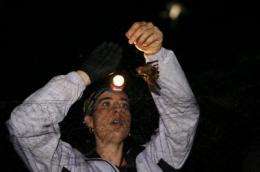Big city holds empty promise for bats

In the treeless, flat Prairie, you'd think a city would provide a good home for bats who like to snuggle up and roost in trees and buildings. But researchers at the University of Calgary made the surprising discovery that the urban landscape is far from ideal for these animals.
"I was really surprised," says Dr. Joanna Coleman, a sessional lecturer and recent PhD graduate in biological sciences at the University of Calgary and lead author of the study. "I fully expected bats to benefit from the expected increase in availability of roosts and food – insects -- in the city. Instead, I found no evidence to support my hypothesis."
This study is the first to assess urban life for Prairie bats. Never before has a proper demographic comparison between urban and non-urban bat populations been performed anywhere.
Researchers predicted that urban bats would have an enhanced body condition, better reproductive rates and increased successful production of juveniles. But the city's tall structures and imported landscape offered an empty promise.
"I figured that if urbanization was going to benefit any bats anywhere, it was
particularly likely to do so for little brown bats in the Prairies," says Coleman, who is currently teaching biology at the University of Calgary's Qatar campus.
"I think little brown bats are drawn to the city in large numbers, and then find themselves having to compete harder to find the resources they need, ultimately to their detriment," says Coleman.
The study looked at 1,600 little brown bats (Myotis lucifugus) because they are the most prevalent in the region in and around Calgary. They also range over much of North America.
Studying bats in the urban environment is important for many reasons, says co-author Dr. Robert Barclay, biological sciences professor at the University of Calgary.
"The effects of urbanization on mammals are not well-studied compared to the effects on birds. Bats play very important roles in ecosystems, acting as primary predators of nocturnal insects, so knowing how they respond to various forms of habitat disturbance is critical," says Barclay.
"Urbanization is rapidly increasing so if we don't perform ecological studies in cities on the premise that they aren't true ecosystems, we're ignoring what is essentially the fastest-growing type of wildlife habitat."
More information: Influence of Urbanization on Demography of Little Brown Bats (Myotis lucifugus) in the Prairies of North America, by Dr. Joanna L. Coleman and Dr. Robert M. R. Barclay, Plos ONE www.plosone.org/article/info%3Adoi%2F10.1371%2Fjournal.pone.0020483
Provided by University of Calgary
















